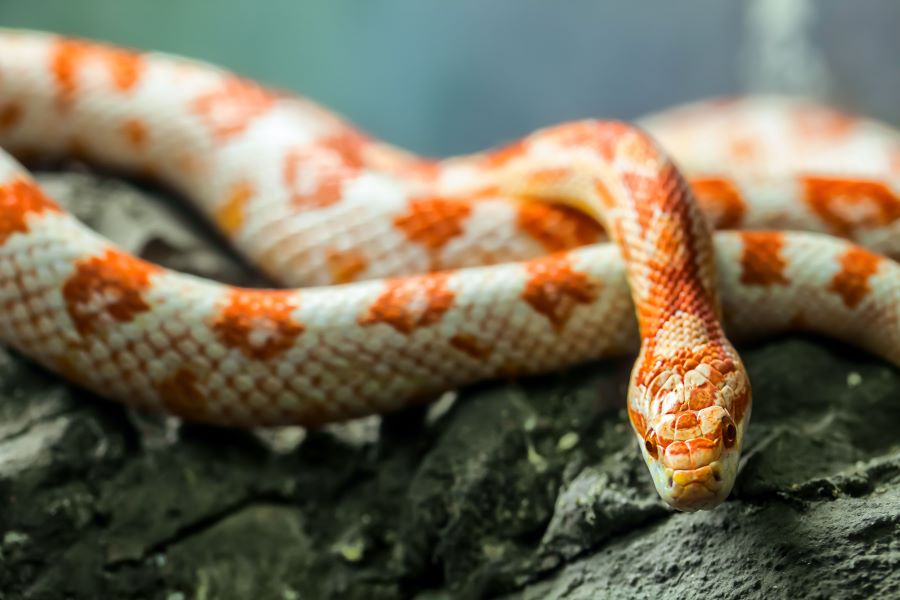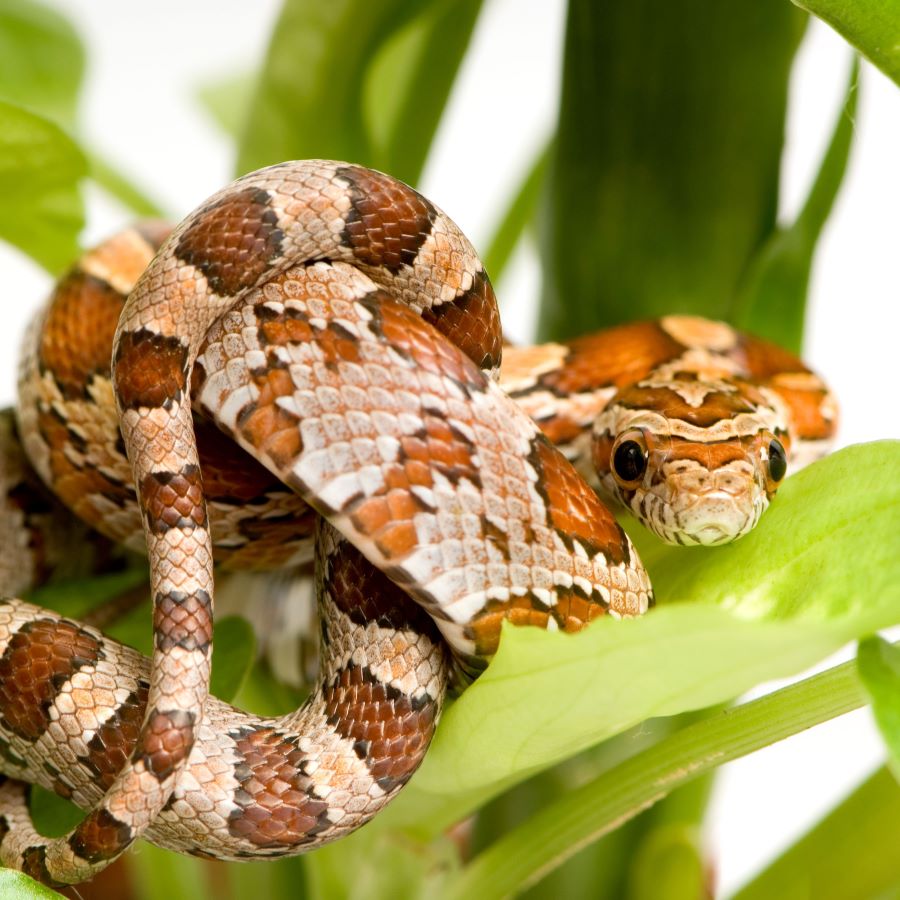Some of the posts on Mercury Pets contain affiliate links to products. That means if you click on that link and then make a purchase, we receive a percentage of the sale. We only recommend products we’ve used and support, and there’s no additional cost to you — the money goes right back into making this site the best it can be! Thanks for reading.

Corn snakes, native to North America, got their name from spending lots of time in cornfields and warehouses. Mice and rats are their favorite prey, and since these animals are abundantly available where corn is stored, it is natural that the corn snakes would gather wherever their favorite snack could be found.
Corn snakes are great options for anyone’s first snake. They are docile, reluctant to bite, and don’t grow very large. They don’t require high-maintenance care and are relatively easy to look after. They are also available in many different color morphs which make them exciting and attractive pets to own.
Corn snakes are also one of the most widely available snakes to buy as pets. They are undoubtedly the best snakes for beginners and, in this article, we explore the reasons why.
Corn Snakes are Perfect for Beginners. Here are 8 Reasons Why.
1. Corn Snakes are Docile Creatures
Corn snakes very rarely get agitated by their surroundings. They are often called the ‘friendliest’ snake species and for good reason. Since they are mostly calm creatures they are suitable to be owned by families, or even responsible children.
When first bought as a hatchling, corn snakes may seem a little erratic. However, with consistent handling, they quickly become calm, attention-loving snakes. So much so that many owners have described their corn snakes as being ‘cuddly.’ As ectotherms (animals who seek out heat), some corn snakes may even try getting under your shirt when you’re handling them.
Corn snakes are entirely non-aggressive snakes, to the point that live prey is not recommended as the mice or rats could injure the snake, and not the other way around.
2. They Don’t Grow Very Large
Large snakes need large tanks and a lot more care. Smaller snakes are fiddly and could be injured if handled the wrong way.
Corn snakes are great for beginners as they don’t grow too big, nor do they stay too small. Averaging between 2 and 5 feet at maturity, they don’t require a huge terrarium and most would be happy in a 20-gallon glass tank. [Source]
This is perfect as many people just starting to look at having snakes as pets might not want to dedicate a lot of money or a huge amount of space until they are certain they are able to care for the reptiles properly.
3. They are Non-Venomous Snakes
Corn snakes are constrictors. This means they kill their prey by twisting themselves around it and squeezing it until it suffocates. As this is their main means of hunting, you shouldn’t be surprised to find out corn snakes are not venomous.
They can bite in extreme situations, but besides being a little painful there is no danger of being affected by the venom.
This makes corn snakes an excellent option for beginners as they are completely safe to handle and there is no fear of accidentally being bitten and then having to be rushed to hospital. They are safe around anyone, from children to adults and even other pets like cats or dogs.
4. They Don’t Like Biting
Since corn snakes are friendly, docile reptiles, it is logical that they might not like biting very much. They are also constrictors, which means they do not need to bite prey in order to eat.
Due to this, it takes a lot of aggravation and annoyance to get a corn snake even close to the point where it might strike at you. As long as you handle it properly at least once a week to help it learn to enjoy human company, the chances of a corn snake biting you is little to none.
As a result of this calm temperament and reluctance to bite corn snakes are the most commonly recommended snakes for beginners.

5. They’re Very Beautiful Snakes
A wild corn snake will have an attractive pattern of reddish-brown bands across a tan or brown body. However, the main beauty of corn snakes lies in their morphs. There are over 40 different corn snake morphs, resulting in a massive variation in their appearance. These morphs are typically divided into 3 main groups; color morphs, pattern morphs, and compound morphs. [Source]
Color Morphs
Color morphs are the most popular, as the banded pattern on the snake’s body could come in a range of colors from brilliant white and red, to golden-yellow. The most common color combinations are red, yellow, and black.
A unique hybrid, known as the Butter morph, looks quite a bit like buttered popcorn. It has golden yellow patches across an all-white base. It is quite amusing to imagine a morph of a corn snake could very well be nicknamed the ‘butter-popcorn snake.’
Pattern Morphs
Pattern morphs create very interesting-looking snakes. They don’t vary in color but in the arrangement of their scales. The most famous Motley morph creates dark bands along the spine and sides of the belly. This is on a white or cream base, creating a stark contrast of color and a very eye-catching appearance.
Compound Morphs
A compound morph is a hybrid of a color and pattern morph. There are dozens of varieties of corn snakes that can be produced by compound morphs and they account for the majority of the most famous morphs around.
In the wild, it may be difficult to find a full range of corn snake morphs. Many of the most popular varieties can only be produced by breeders specializing in a few different morphs.
The fact that corn snakes are available in so many different color and pattern arrangements makes them very interesting, pretty, and a great option for any beginner.
6. They can be Housed Together if Necessary
Although it is not the optimum living arrangement, it is not impossible to house two corn snakes together.
Provided they are both adults of the same sex, and the vivarium is large enough, it is possible to house them together without any major problems. This should only be done on a temporary basis, however, as there may be issues like cannibalism or aggression between the corn snakes (especially males) to look out for.
It is also recommended to feed the snakes separately, should they share a living space.
The easygoing nature of corn snakes makes them great for beginners. Housing two snakes of another species together could have dire and heartbreaking consequences. Thankfully, two corn snakes being put in the same tank, even for a little while, shouldn’t cause any harm.
7. Taking Care of a Corn Snake is Relatively Easy
New snake owners may sometimes feel overwhelmed by the amount of information available on snake husbandry. There is humidity to think of, temperature, bedding, heat lamps, and so much more that it might all seem too much to learn at once.
That is where corn snakes shine. Preferring temperate climates, they only need an ambient atmosphere around 80-85 degrees Fahrenheit. They can also manage at standard household humidity, except when they are shedding when it should be increased. Adult corn snakes also only need to be fed about once a week. [Source]
All this means they are perfect for first-time snake owners who might not feel confident caring for a fussy snake.
8. They can be Handled for Long Periods of Time
If handling time is built up gradually, corn snakes have no problem being outside their vivarium, being played with or handled for up to 20 minutes at a time. This can be repeated daily as long as the corn snake doesn’t seem agitated.
Many owners may take their corn snakes out more than once a day, this simply depends on the snake and its mood at the time.
Their affinity for being handled is another reason why corn snakes make great pets for beginners. They will eventually grow to love spending time with their people which makes them incredibly fun and rewarding snakes to own.
Conclusion
Corn snakes’ calm temperament, enjoyment of human company, and simple care regimen make them excellent options for reptile lovers looking for their very first pet snake. Far from being boring, corn snakes come in dozens of different colors and patterns and are happy to spend extensive time outside their enclosure being shown off and handled.
All of these factors, along with the certainty that they are non-venomous and incredibly reluctant to bite, make them some of the best snakes out there for someone looking to gain experience in the world of snake and reptile husbandry.



